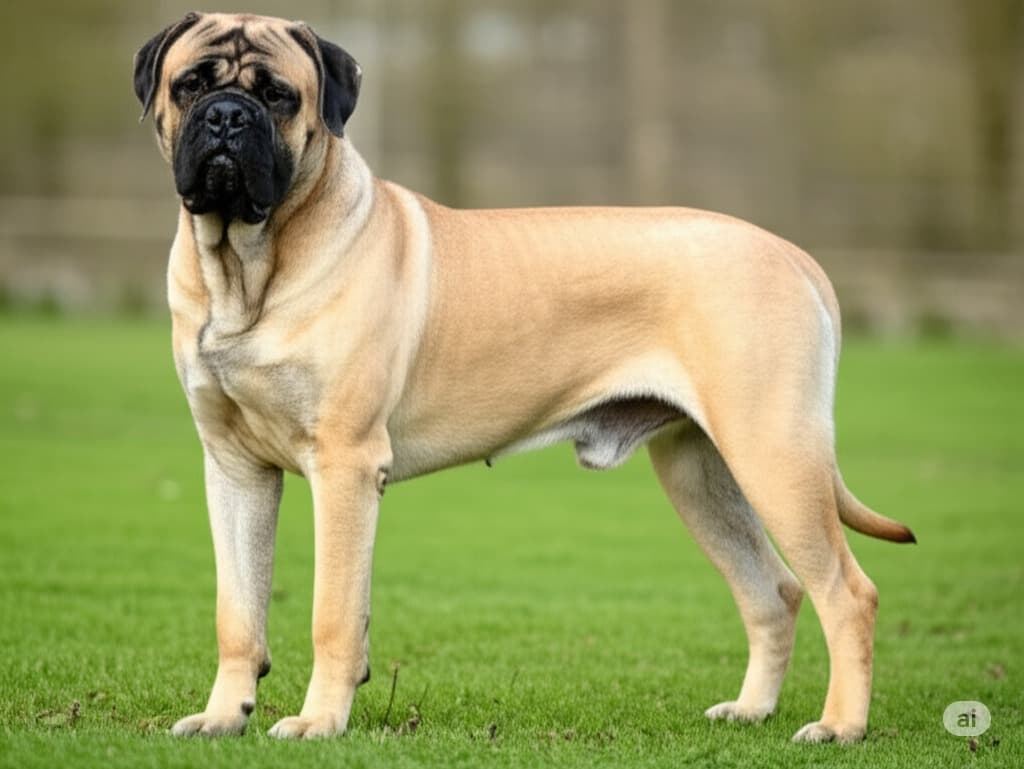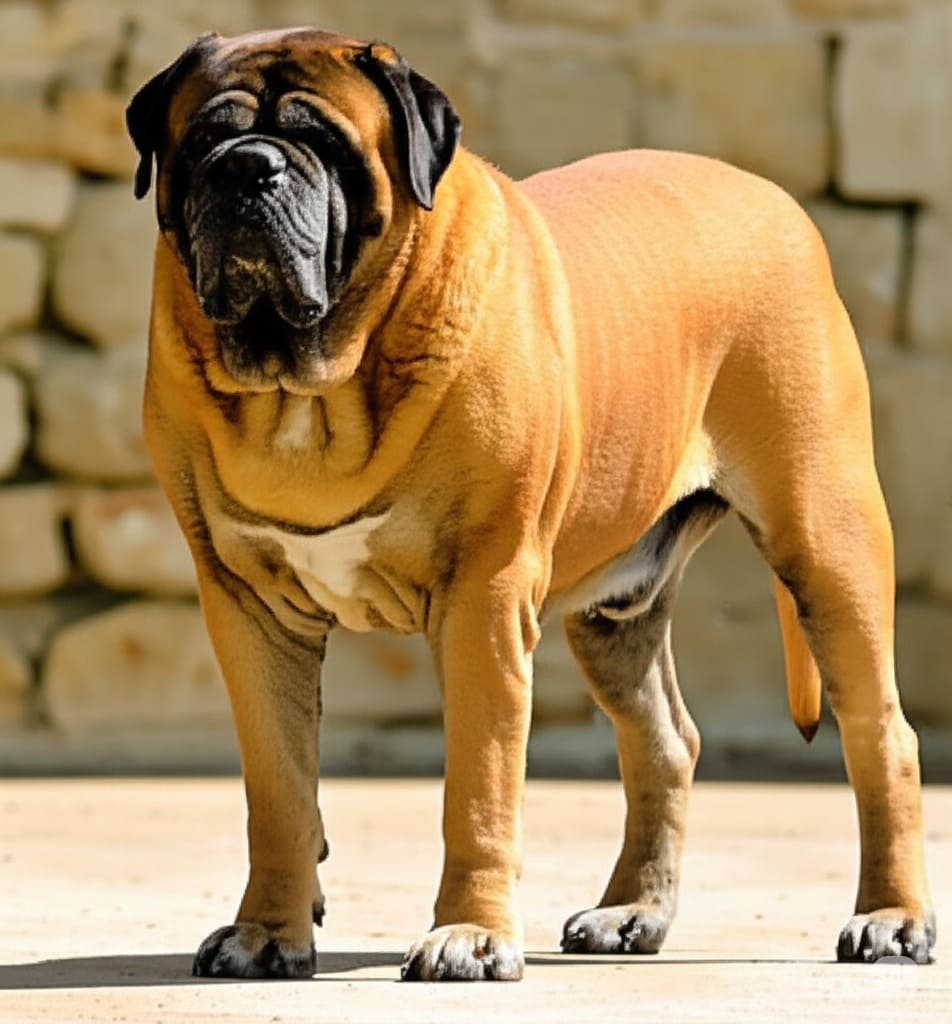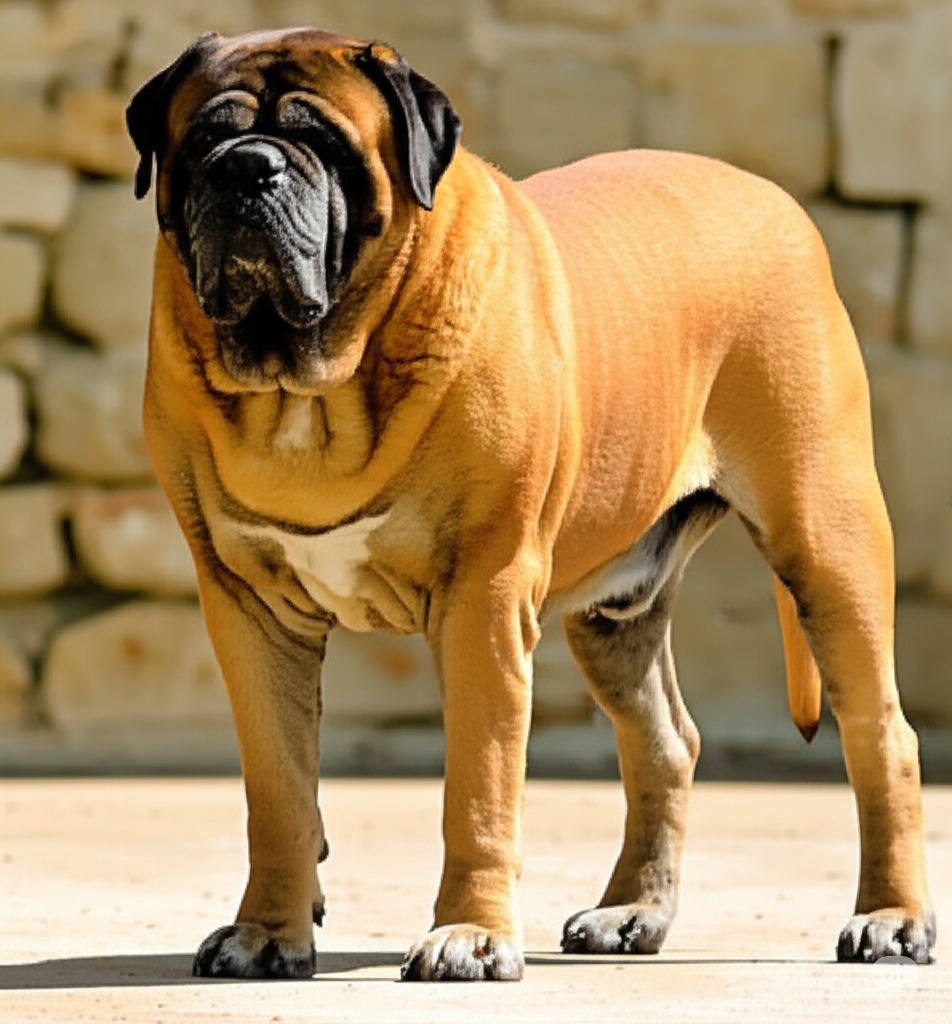
English Mastiff
The English Mastiff, a colossal member of the Working Group, embodies canine grandeur and ancient lineage. Renowned for their immense size yet gentle, loyal, and dignified nature, these 'gentle giants' have transitioned from historical roles as war dogs and estate guardians to cherished family companions. Understanding their unique blend of protective instincts, calm demeanor, and specific care requirements is essential for prospective owners of this magnificent breed.
Important Disclaimer:The information provided on this page about the English Mastiff is intended for general knowledge and informational purposes only and does not constitute professional veterinary advice. Always consult with a qualified veterinarian for any health concerns or medical conditions related to your dog. The breed identification provided by our AI tool is a prediction and should not be considered a definitive diagnosis.
English Mastiff Dog Breed Overview
- Breed Group
- Working
- Origin
- England (Ancient lineage tracing back to Asia/ancient Britain)
- Purpose
- Historical: War Dog, Estate Guardian, Hunter, Baiting Dog. Modern: Family Companion, Watchdog
- Size
- Large to Giant
- Other Names
- Mastiff, Old English Mastiff
- Lifespan
- 6-10 years (some up to 12)
- Temperament
- GentleLoyalProtectiveDignifiedDocileCourageousAffectionateGood-naturedCalmSelf-assuredSteadyReserved (with strangers)
- Activity Level
- Low to Moderate
- Trainability
- Moderate (Intelligent but can be stubborn/independent)
- Grooming
- Low
- Shedding
- Low (with seasonal heavy shedding)
- Barking
- Low (Typically quiet, barks to alert)
- Good with
- Health Issues
- Hip DysplasiaElbow DysplasiaBloat (Gastric Dilatation-Volvulus - GDV)Heart Conditions (e.g., Dilated Cardiomyopathy)Eye Problems (Entropion, Ectropion)Osteosarcoma (Bone Cancer)Heat Sensitivity / HeatstrokeObesity
- Suited For
- Owners prepared for a giant breed (space, cost, drool)
- Families seeking a loyal, gentle guardian
- Homes with a securely fenced yard
- Owners committed to early socialization and consistent, patient training
- Those appreciating a calm indoor companion requiring moderate exercise
- Families, Children (supervised)
English Mastiff History & Origin: Popularity of English Mastiffs
The English Mastiff, a colossal member of the Working Group, embodies canine grandeur and ancient lineage. Renowned for their immense size yet gentle, loyal, and dignified nature, these 'gentle giants' have transitioned from historical roles as war dogs and estate guardians to cherished family companions. Understanding their unique blend of protective instincts, calm demeanor, and specific care requirements is essential for prospective owners of this magnificent breed.

English Mastiff's cute puppy 😍
History of English Mastiff
The Mastiff's lineage dates back potentially 4500 years, with evidence in ancient Babylonian art depicting similar dogs hunting lions.
Believed to have arrived in Britain via Phoenician traders, these dogs impressed Romans during Caesar's invasion (55 BC) with their courage.
Used by Celts as war dogs and later in blood sports (bull/bear-baiting) through medieval times. The name 'Mastiff' appeared in English by 1465.
The Lyme Hall strain, founded by Sir Piers Legh's Mastiff after the Battle of Agincourt (1415), is historically significant.
Mastiffs likely arrived in America on the Mayflower (1620), with documented imports increasing in the late 1800s. AKC recognized the breed in 1885.
The breed faced near extinction after WWI but was revived through dedicated breeding efforts using imports from Britain and Canada.
Purpose and Popularity of English Mastiff
Historically served as war dogs, formidable guardians of estates and livestock (often let loose at night), hunting dogs, and participants in blood sports.
Today, they are primarily cherished family companions, valued for their gentle, affectionate nature combined with inherent loyalty and protective instincts.
Their size and deep bark act as natural deterrents, making them effective watchdogs without needing overt aggression.
While not always top-ranked, the breed enjoys enduring popularity and a dedicated following among giant breed enthusiasts worldwide.
Did you know?
A female Mastiff belonging to Sir Piers Legh famously guarded him on the battlefield after he was wounded at the Battle of Agincourt in 1415, later founding the renowned Lyme Hall Mastiff line. The largest recorded Mastiff, named Zorba, reached an astonishing weight of 343 pounds.
English Mastiff Dog Breed Size and Physical Traits
Size of English Mastiff dog Breeds
Size Category
Large to Giant
Height
Male
30-36 inches (76-91 cm)
Female
27.5-32 inches (70-81 cm)
Weight
Male
160-230 pounds (72-104 kg)
Female
120-170 pounds (54-77 kg)
Appearance of English Mastiff dog Breeds
- Coat Type
- Short, dense, flat
- Eye Size & Color
- Medium-sized, dark, set wide apart
- Ear Size & Shape
- Moderately sized, V-shaped, set high and wide, lying close to cheeks
- Tail
- Set high, wide at base, tapering to end, carried low or with slight curve
Description of English Mastiffs Appearance

👀 How big is an English Mastiff? - Giant
- The English Mastiff is a breed of imposing grandeur, characterized by its massive size and symmetrical, heavy-boned structure.
- Males stand at least 30 inches tall, weighing 160-230 pounds or more, while females reach at least 27.5 inches and weigh 120-170 pounds.
- Their head is large and broad with noticeable wrinkles and a distinctive black mask over the short muzzle, contrasting with their apricot, brindle, or fawn short, dense coat.
- Dark, medium-sized eyes and V-shaped ears contribute to their dignified, gentle expression.
- Despite their power, they move with purpose, embodying the essence of a 'gentle giant'.
Coat Colors of English Mastiff dogs
Distinctive Features of English Mastiff dog breeds
- English Mastiffs are known for their immense size combined with gentle temperament ('Gentle Giant')
- They have a characteristic black mask on muzzle, often extending to eyes/ears
- They possess large, massive, broad head with wrinkles (esp. forehead)
- They have powerful, heavy-boned, symmetrical, rectangular body
- They have short, dense coat in apricot, brindle, or fawn colors
- They bear a noble, dignified expression and bearing
- Their tendency to drool is a common trait.
English Mastiff Environment, Barking, Trainability and More...
Barking Level of English Mastiff
English Mastiffs are typically quiet dogs. They are not prone to nuisance barking but will use their deep bark to alert owners to perceived threats or visitors.
Trainability of English Mastiff
Intelligent and generally willing to please, Mastiffs can also be stubborn or independent. They respond best to patient, consistent, positive reinforcement training methods. Harsh corrections are counterproductive.
Energy Level of English Mastiff
Mastiffs have relatively low energy levels compared to their size. Moderate daily exercise, like walks (~30 min) and playtime, is sufficient to keep them healthy. They are often calm indoors.
Friendly Environment Description of English Mastiffs
- Mastiffs thrive as indoor companions, deeply bonded with their families and enjoying close physical contact.
- While adaptable, their large size necessitates ample living space; a house with a securely fenced yard is ideal, though they can adapt to apartments if exercise needs are met.
- Early and ongoing socialization is crucial for appropriate interactions with strangers and other animals.
- They can be territorial, especially males towards other males, and caution is needed around small pets due to potential prey drive.
- Mastiffs are sensitive to heat and require protection in warm weather.

🏠 English mastiff with its entire family
Personality Traits of English Mastiff dog breed
Nature
A quintessential 'gentle giant,' combining immense power with a docile, dignified, and deeply affectionate nature towards family.
Affectionate
Extremely affectionate with their families, often seeking physical closeness like resting their head on laps.
With Children
Typically good-natured and tolerant with children in their family, but supervision is essential due to their sheer size.
With Other Dogs
Can coexist peacefully, especially if raised together and well-socialized, but potential for territoriality and same-sex (male) aggression exists.
With Strangers
Naturally reserved, watchful, and protective. Generally accepting once they gauge their owner's reaction.
Protective
Possesses strong inherent protective instincts, making them excellent natural watchdogs. Their presence alone is often a deterrent.
Adaptability
Adapts reasonably well to routine and changes. Sensitive to heat. Can manage apartment life with sufficient exercise but thrives best with more space.
English Mastiffs are good with:
English Mastiff Dog Breed Care & Grooming Needs
Shedding Level of English Mastiff
English Mastiffs have short coat and shed low but experience seasonal heavy shedding. This heavy shedding periods typically comes once or twice a year. Regular brushing helps manage this.
Grooming Needs of English Mastiff
Grooming needs of English Mastiffs are minimal. Brush every few days, bathe occasionally (every few months or as needed), trim nails regularly, check/clean ears, and importantly, clean facial wrinkles.
Grooming Tips
Use a rubber brush or grooming mitt for weekly brushing. Bathe infrequently. Pay special attention to cleaning and thoroughly drying facial wrinkles to prevent infections. Regularly check ears and trim nails.
Drooling Frequency of English Mastiff
English Mastiffs are known for drooling, sometimes significantly, especially those with looser jowls. Prospective owners should be prepared with towels.
English Mastiffs Daily Exercise Requirements
Minimum Daily Activity of English Mastiff
30 minutes per day
English Mastiffs require moderate daily exercise like gentle walks or playtime. Avoid over-exercising puppies to protect developing joints. Be cautious in heat.
Recommended Activities for English Mastiffs
Living Space Compatibility of English Mastiffs
Yard Requirement
A securely fenced yard is crucial for providing safe space for exercise and managing their protective instincts.
Apartment Living: Not Ideal
Can adapt if exercise needs are rigorously met, but their large size makes apartment living challenging. A house is preferred. Apartment living is not ideal for English Mastiffs unless the owner is very committed.
Living Considerations for English Mastiffs
- Requires significant space due to giant size.
- Substantial financial commitment for food, vet care, etc.
- Tendency to drool requires tolerance.
- Needs early and consistent socialization and patient training.
- Sensitivity to heat requires careful management.
- Relatively short lifespan compared to smaller breeds.
- Potential for stubbornness.
English Mastiff Dog Lifespan and Health Issues
Average Lifespan of English Mastiffs
Common Health Issues of English Mastiffs
Hip and Elbow Dysplasia
Abnormal development of the hip and elbow joints, common in large breeds.
Bloat (Gastric Dilatation-Volvulus - GDV)
Life-threatening twisting of the stomach, a risk for deep-chested breeds.
Heart Conditions (e.g., Dilated Cardiomyopathy - DCM)
Conditions affecting the heart muscle and its ability to pump blood.
Eye Problems (Entropion/Ectropion)
Inward or outward turning of the eyelids, potentially causing irritation.
Osteosarcoma
An aggressive form of bone cancer.
Heat Sensitivity / Heatstroke
Prone to overheating due to large size and potentially short muzzle.
Obesity
Can exacerbate joint problems and other health issues.
Preventative Care of English Mastiffs
- Choose reputable breeders who screen for genetic health conditions.
- Feed a high-quality diet appropriate for giant breeds, managing weight carefully.
- Provide moderate exercise, avoiding overexertion (esp. puppies/heat).
- Regular veterinary check-ups for early detection of issues.
- Take precautions against bloat (e.g., feeding schedule, slow feeders).
- Maintain proper grooming, including wrinkle and ear care.
What to feed English Mastiff? English Mastiff's diet and Nutrition
Recommended Diet for English Mastiff dog breed
High-quality commercial dog food formulated for large or giant breeds, specific to life stage (puppy, adult, senior). Consult with a veterinarian.
Typical Feeding Schedule of English Mastiffs
| Age Group | Feeding Frequency |
|---|---|
| Puppies | Multiple meals per day (follow breeder/vet advice) |
| Adults | Typically 2 meals per day |
| Seniors | May need adjustments based on health/activity, often 2 meals/day |
Sensitivities & Considerations of English Mastiffs
Potential Food Sensitivities of English Mastiffs
Some Mastiffs may develop sensitivities. Monitor for signs like skin issues or digestive upset and consult a vet if suspected.
Dietary Considerations of English Mastiffs
- Use giant breed puppy formula to support proper growth rate.
- Strict portion control to prevent obesity is crucial for joint health.
- Avoid feeding table scraps or excessive treats.
- Ensure constant access to fresh, clean water.
- Consider using slow-feeder bowls to reduce bloat risk.
- Avoid strenuous exercise immediately before or after meals.
Weight Management of English Mastiffs
Maintaining a lean body condition is vital. Easily feeling ribs without seeing them and observing a waistline are good indicators. Work with your vet.
Signs of Healthy Weight of English Mastiffs
- Ribs easily palpable with a slight fat covering.
- Visible waistline when viewed from above.
- Abdomen tucked up behind the rib cage when viewed from the side.
Tips for Healthy Feeding of English Mastiffs
- Measure food accurately.
- Adjust portions based on age, activity, metabolism, and body condition.
- Feed at consistent times.
- Use a slow-feeder if prone to eating quickly.
- Monitor weight regularly.
Is English Mastiff a good match for you?
The English Mastiff is best suited for experienced owners, or dedicated novices, prepared for the unique responsibilities of a giant breed. They need space, consistent training, socialization, and owners who appreciate their gentle nature while managing their size and potential stubbornness.
English Mastiffs are a Great Match For
- Individuals/Families seeking a large, loyal, protective yet gentle companion.
- Owners with ample living space and a securely fenced yard.
- People committed to early, consistent, positive reinforcement training and socialization.
- Those prepared for the financial commitments of a giant breed (food, vet care).
- Owners who can provide moderate daily exercise.
- People tolerant of drooling.
- Households where the dog can be an indoor companion.
English Mastiffs May be Challenging For
- First-time owners unprepared for giant breed management.
- Those with limited living space or no secure yard.
- People seeking a highly energetic or athletic dog.
- Owners unable or unwilling to invest time in training and socialization.
- Individuals intolerant of drool or large amounts of dog hair (during shedding).
- Those on a tight budget (giant breed costs are high).
- People living in very hot climates without appropriate accommodations.





